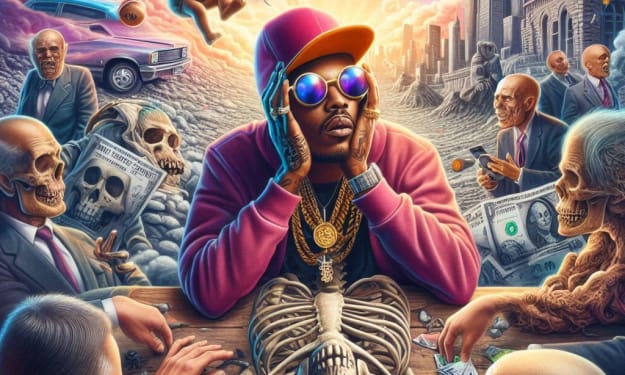Debunking the Myth: Unveiling The Truth Behind Blue State vs. Red State Crime Rates
How Politics and Perception Shape Our Understanding of Crime Statistics

In American politics, crime rates are often weaponized in partisan debates, with Republicans frequently portraying blue states as crime-ridden havens of lawlessness. This narrative, however, is not supported by factual data. Instead, the statistics reveal a more complex and often contradictory reality, where red states consistently show higher crime and murder rates. This article aims to debunk the myth that blue states are inherently more dangerous and examines how political rhetoric distorts public perception of crime.
Republican politicians and commentators frequently claim that Democratic-led states and cities suffer from rampant crime due to liberal policies. They argue that progressive approaches to law enforcement, criminal justice reform, and social services create environments where crime flourishes. High-profile incidents and media coverage of violent events in cities like New York, Chicago, and Los Angeles are often cited as evidence of this alleged epidemic of crime.
However, this narrative is not borne out by a comprehensive analysis of crime statistics. While individual cities may experience spikes in certain types of crime, the overall crime rates in blue states are not disproportionately higher than those in red states. In fact, a closer examination reveals that red states often lead in various crime metrics, including violent crime and murder rates.
Statistical data consistently show that many red states have some of the highest crime rates in the country. According to the FBI's Uniform Crime Reporting (UCR) program and other reputable sources, states like Louisiana, Mississippi, and Missouri regularly top the charts for violent crime and homicide rates. For instance, Louisiana has been the state with the highest murder rate for several years running, a fact that starkly contrasts with the image of blue state violence.
Violent crime, which includes offenses such as murder, rape, robbery, and aggravated assault, tends to be higher in several red states. For example, in 2020, Tennessee and Arkansas, both solidly red states, had violent crime rates significantly above the national average. These rates were higher than those in many blue states, including New York and California.
When it comes to murder rates, the disparity is even more pronounced. According to the Centers for Disease Control and Prevention (CDC), the top states for homicides per capita include several red states. In 2020, Mississippi had the highest homicide rate in the country, followed closely by Louisiana and Alabama. By contrast, many blue states had significantly lower murder rates, challenging the narrative that liberal policies lead to more murders.
Understanding why red states often have higher crime rates requires a deeper look into the socioeconomic factors at play. Poverty, education, and access to resources are critical determinants of crime. Many red states suffer from higher poverty rates, lower educational attainment, and limited access to healthcare and social services. These factors contribute to higher crime rates and are often exacerbated by policies that do not address these underlying issues.
Poverty is a well-documented driver of crime. States with higher poverty rates tend to experience higher crime rates, as economic hardship can lead to increased desperation and criminal activity. Many red states, including Mississippi and West Virginia, have some of the highest poverty rates in the nation, correlating with their higher crime rates.
Educational attainment is another critical factor. States with lower high school graduation rates and limited access to higher education often see higher crime rates. Red states like Arkansas and Oklahoma have lower educational outcomes compared to blue states, contributing to their higher levels of violent crime.
Policy decisions at the state level also play a significant role in shaping crime rates. Red states often prioritize different policies compared to blue states, particularly regarding social services, criminal justice, and gun control.
Many red states have more punitive criminal justice systems, focusing on incarceration rather than rehabilitation. This approach can lead to higher recidivism rates and does not address the root causes of crime. In contrast, blue states often invest more in rehabilitation and prevention programs, which can be more effective in reducing crime over the long term.
Gun control is another contentious issue. States with more permissive gun laws often see higher rates of gun violence. Many red states have lax gun control regulations, contributing to higher rates of gun-related crimes and homicides. By contrast, blue states with stricter gun laws often report lower rates of gun violence.
The perception of crime is heavily influenced by media coverage and political rhetoric. High-profile incidents in blue states receive extensive media attention, often overshadowing similar or worse incidents in red states. This selective coverage can create a skewed perception of where crime is most prevalent.
Republican politicians and media outlets amplify these perceptions for political gain, reinforcing the narrative that blue states are more dangerous. This strategy taps into public fears and can sway opinions, even when the underlying data contradicts these claims.
The myth that blue states are inherently more dangerous than red states is not supported by the facts. A detailed analysis of crime statistics reveals that many red states suffer from higher crime and murder rates. Socioeconomic factors, policy choices, and political rhetoric all play significant roles in shaping public perceptions of crime.
Debunking this myth is essential for a more accurate understanding of crime in America. It highlights the need for evidence-based policy decisions and a broader discussion about the root causes of crime, beyond partisan politics. Only by addressing these underlying issues can we hope to create safer communities across the country.
About the Creator
Enjoyed the story? Support the Creator.
Subscribe for free to receive all their stories in your feed. You could also pledge your support or give them a one-off tip, letting them know you appreciate their work.






Comments
There are no comments for this story
Be the first to respond and start the conversation.